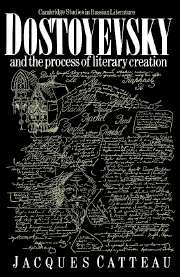Book contents
- Frontmatter
- Contents
- Preface to the English edition
- List of abbreviations
- General editor's note on transliteration and references
- General introduction
- PART I The creative environment
- PART II The process of creation
- Introduction
- 7 The writer at work
- 8 The great dialogue: the news item
- 9 The great dialogue: migrant images
- 10 The play of dialogue
- 11 The unity of thought in the novel
- 12 The summit of creative interrogation: ‘The Life of a Great Sinner’
- 13 A Raw Youth: reasons for choice
- 14 A Raw Youth: the appearance of the vision
- 15 A Raw Youth: the human architecture
- 16 A Raw Youth: the Idea of the novel
- 17 The composition of the novel in Dostoyevsky's work: choice of chronicle form
- 18 Composition of the novel in A Raw Youth: chronicle and stories
- Part III Time and space in the world of the novels
- Conclusion
- Notes
- Select bibliography
- Index of names
16 - A Raw Youth: the Idea of the novel
Published online by Cambridge University Press: 18 December 2009
- Frontmatter
- Contents
- Preface to the English edition
- List of abbreviations
- General editor's note on transliteration and references
- General introduction
- PART I The creative environment
- PART II The process of creation
- Introduction
- 7 The writer at work
- 8 The great dialogue: the news item
- 9 The great dialogue: migrant images
- 10 The play of dialogue
- 11 The unity of thought in the novel
- 12 The summit of creative interrogation: ‘The Life of a Great Sinner’
- 13 A Raw Youth: reasons for choice
- 14 A Raw Youth: the appearance of the vision
- 15 A Raw Youth: the human architecture
- 16 A Raw Youth: the Idea of the novel
- 17 The composition of the novel in Dostoyevsky's work: choice of chronicle form
- 18 Composition of the novel in A Raw Youth: chronicle and stories
- Part III Time and space in the world of the novels
- Conclusion
- Notes
- Select bibliography
- Index of names
Summary
Decomposition is the main visible thought of the novel.
Dostoyevsky in the notebooks of A Raw YouthConfusion of critical ideas
Dostoyevsky's work glows with ideas, as some people glow with health. It arouses more passion and intolerance, inside and outside Russia, than the work of any other writer, furnishing ideologists of all sorts – Christians and atheists, friends and enemies of socialism, egoists and universalists, not counting psychoanalysts, existentialists personalists, and so on – with endless ammunition for their battles. Dostoyevsky, who loved philosophy, would not have questioned anyone's right to make use of any of the ideas in his novels, or at least to take up the theories embodied by his heroes.
This is not the same as saying that Dostoyevsky was a master of the philosophical novel. Engelgardt's idea that his work reveals ‘the distinct links of a complex philosophic construction expressing the history of the gradual formation of the human spirit’ contradicts the novelist's basic inclination, which was, as we saw in ‘The Life of a Great Sinner’, to reject historical time in order to preserve human freedom by extending it in space. Dostoyevsky was not a Hegelian, but a novelist who interrogated man in the idea made act. As an artist, writes V. Ya. Kirpotin, ‘he never limited himself to the antinomy or even the dialectic of the idea in itself, but tested it in practice’.
- Type
- Chapter
- Information
- Dostoyevsky and the Process of Literary Creation , pp. 285 - 295Publisher: Cambridge University PressPrint publication year: 1989



